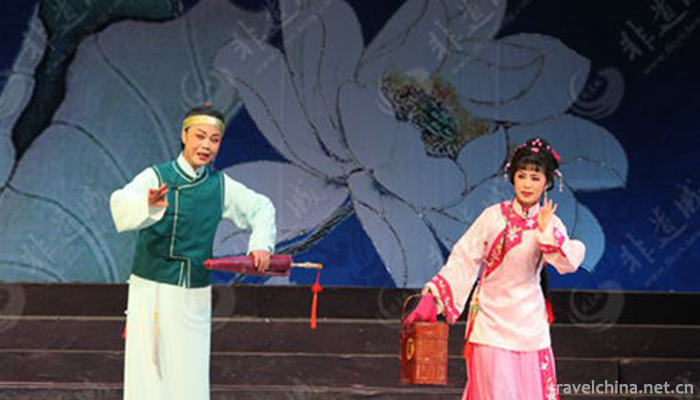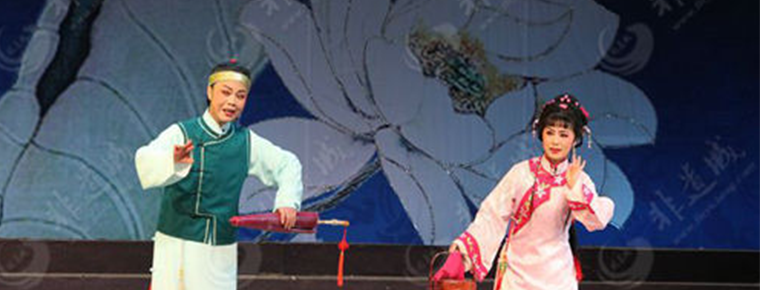Lake Opera
Lake Opera
Huzhou Tanhuang, originally known as Huzhou Tanhuang, is a traditional local opera. It is mainly popular in Huzhou, Jiaxing, Yuhang and Linan of Hangzhou, Wujiang and Yixing of Jiangsu, Guangde of Anhui, etc. It has a history of about 100 years. Wuxing was named Huzhou Opera in 1951 because it belonged to Huzhou Prefecture. Huju opera has a strong water-village sentiment in the south of the Yangtze River. It is not only friendly and soft in language (singing in Huzhou dialect of Wu dialect), but also fresh and smooth in melody. It is also elegant and delicate in performance, and suitable for performing family love drama with joy and sorrow.
In June 2007, Hu Opera was listed in the second batch of representative works of intangible cultural heritage in Zhejiang Province.
On May 23, 2011, Huzhou City, Zhejiang Province declared "Huju Opera" which was approved by the State Council and listed in the third batch of national intangible cultural heritage list.
Inheritance and protection
Hu Opera is one of the local operas in Zhejiang Province and the only one in the northern part of Zhejiang Province. In its more than one hundred years of development history, Huzhou Opera has created many vivid and moving artistic images with its rich local features, repertoires and musical performances, reflecting the unique local customs of Huzhou area. After the founding of New China, a number of excellent dramas such as the ancient costume drama Kirin Belt, the newly written historical drama Great Wall Song and the modern drama Taihu Honglang have been created by the people in the Hu opera circle. These plays have been performed by Huzhou Huzhou Huzhou Theatre Troupe, making them present to the audience perfectly, thus satisfying and enriching people's cultural life. Since the 1980s, due to various factors, the performance of the opera has been depressed. Like other operas, the performance of the lake opera has encountered great difficulties. However, Huzhou Huzhou Drama Troupe still insists on creation and performance in its predicament. The troupe has created and performed modern operas such as "Taiping Bridge" and "Cave Variations" successively, and achieved good results in provincial and municipal drama festivals, which also has a certain influence in China. In 1992, at the invitation of the Ministry of Culture, the delegation also went to Fujian to participate in the excellent performance of "the first group in the world" organized by the Ministry of Culture, and won high praise. However, with the strengthening of market-oriented trend and the acceleration of modernization process, great changes have taken place in the cultural ecology of our country. Some cultural heritages relying on dictation and behavior are disappearing. Many traditional skills are on the verge of extinction. Traditional and diverse folk cultures have been strongly impacted by large-scale socialized production and foreign cultures. Affected by the overall social environment, Huzhou Huzhou Huzhou Drama Troupe withdrew in 2000 and Huzhou Drama was on the verge of extinction. Nowadays, most of the older generation of Lake opera artists are over the age of six or seventy, and the situation of aging and lack of successors is serious. It is urgent to protect and inherit the traditional culture of Hu Opera.
Hu Opera is a traditional cultural expression form and cultural space closely related to people's life, which is inherited from generation to generation. It is also a witness of historical development and an extremely important cultural resource. Therefore, the protection and inheritance of Hu Opera is particularly necessary for the construction of a large cultural province and a large cultural city, and for the protection and promotion of traditional culture.
On May 18, 2010, the Ministry of Culture of China announced the third batch of national intangible cultural heritage list of recommended projects (new entries). Huzhou City of Zhejiang Province declared "Huju Opera" as a non-material cultural heritage in the category of traditional drama projects.


-
1.waterless rice noodle
Bait silk is one of the special snacks in Yunnan. It is mainly made from rice
Time 2018-10-17 -
2.Arctic Village Tourism Scenic Area
Arctic Village Tourist Scenic Spot: National AAAAA Class Tourist Spot, the most attractive scenic spot in 2014, and the northernmost scenic spot in China.
Time 2018-12-05 -
3.Jinshan City Beach Shanghai
Jinshan City Beach is located in Jinshan District of Shanghai, located in the southwest of Shanghai and the North Bank of Hangzhou Bay. It is adjacent to Pinghu and Jiashan City in Zhejiang Province
Time 2018-12-19 -
4.Chaoyang Bird Fossil National Geological Park
Chaoyang Bird Fossil World Geopark is located in Chaoyang City, western Liaoning Province. Chaoyang is located at the junction of Liaoning, Hebei and Mongolia provinces in the throat of Chinese cock t
Time 2019-01-05 -
5.Liao Zhai City
Liaozhai City was invested and built by Pujiazhuang, Zichuan. It is a large-scale famous garden scenic area with gardens as its manifestation and Liaozhai stories as its theme
Time 2019-01-30 -
6.Qianchuan Scenic Spot
Qianchuan Scenic Spot, a national-level scenic spot announced by the State Council in 2004, is situated on the Bank of the Yellow River 20 kilometers east of Heyang County
Time 2019-02-07 -
7.Xigaosong Scenic Spot
Xiqiaosong Scenic Area is located at the foot of Tianjing Mountain, 13 kilometers west of Chengxian County, in the middle of Yuqiaoxia, a national AAAA-level tourist attraction
Time 2019-02-25 -
8.Bangkok in Puzhou
Bangzi of Puzhou is named for its origin in ancient Puzhou. Jinzhong and Northern Shanxi are called "Bangzi on the South Road" or "Bangzi Opera on the South Road", Shangdang is cal
Time 2019-06-09 -
9.Bronze Ware Making Skills Datong Copper Ware Making Skills
Datong bronze ware is a traditional handicraft of the Han nationality. It has a long history and exquisite craftsmanship. As early as the Northern Wei Dynasty, it enjoyed a great reputation. Since the
Time 2019-06-21 -
10.Leshan peoples life
By the end of 2018, the per capita disposable income of rural residents in Leshan City was 15173 yuan, an increase of 8.9%, and the per capita living consumption expenditure was 12309 yuan, an increase of 9.5%. The per capita disposable income of urban residents
Time 2020-12-17 -
11.Nanchong medical and health
By the end of 2019, Nanchong has 8457 medical and health institutions (including village clinics), including 166 hospitals and 8250 primary medical and health institutions. The number of beds in medical and health institutions was 43726, an increase of 4.9% over 2018
Time 2020-12-17 -
12.Guangan economy
In 2019, the GDP of Guang'an City will reach 125.04 billion yuan, an increase of 7.5% over the previous year (the same below). Among them, the added value of the primary industry was 20.43 billion yuan, an increase of 2.8%; the added value of the secon
Time 2020-12-19